9 Rhubarb FAQs You Need to Know
Here are the rhubarb FAQs I hear most often. Understanding your rhubarb plant will help you make the most of this delicious plant that’s perfect for sweet and savoury recipes.

Also read: How and When to Harvest Rhubarb, How to Freeze Rhubarb, Rhubarb eCookbook
Take the rhubarb quiz. Read the following rhubarb FAQs. Can you answer them correctly before reading the answer? No peeking!
Top 9 Rhubarb FAQs
1. Are rhubarb leaves really poisonous?
Yes, rhubarb leaves are really poisonous. High levels of oxalates and anthraquinone glycosides that are present in rhubarb leaves are believed to be the culprits.
Having confirmed that the leaves are poisonous, let’s keep things in perspective. You would need to eat a lot of rhubarb leaves (some estimate a 150 lb adult would need to eat about 11 lbs of rhubarb leaves) to cause death. However, smaller quantities may cause a burning sensation in your mouth and throat, difficulty breathing, diarrhea, eye pain, nausea, stomach pain, vomiting, kidney stones, seizures, or coma.
In other words – DO NOT eat the leaves! Chop them off and put them in your compost.
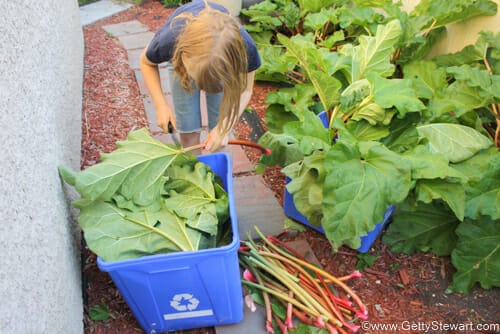
2. Can I put rhubarb leaves in my compost?
YES you can compost rhubarb leaves. Since we don’t eat our compost pile, there is no danger to us. And, because the components break down so quickly, there’s no danger to the microbes in your compost bin either. Even when you finally use your compost, the acids will have been decomposed and won’t affect whatever you may be growing.

3. How do I know when my rhubarb is ready to harvest?
Probably the number one rhubarb FAQs of all time! Do not wait until the stalks turn red! You might be waiting for a long time since not all rhubarb varieties are red. Instead, rely on the size of your rhubarb. Start harvesting when stems are about 25 cm or 7 inches long. Check out my latest video for some more information on rhubarb harvesting.
I’ve been fortunate to have harvested three different varieties of rhubarb in one day – lime green, mottled green and red, all were perfectly ripe.

Video: When is rhubarb ready to harvest?
4. What’s the proper way to pick rhubarb?
The ideal method is to pull out the stalks starting from the outside of the plant and working your way to the middle. Run your hand down the stem until you’re close to the ground then gently pull with a little twist. The stem should come right out.
By pulling rather than cutting your rhubarb, the plant recovers a little more quickly. But if it’s too difficult to reach, you can use a sharp knife to cut the stalks as close to the ground as possible. The plant will take just a little longer to recover.
Be sure to leave at least 1/3 of the rhubarb stalks standing. This will ensure your rhubarb plant will thrive and continue to grow year in and year out.
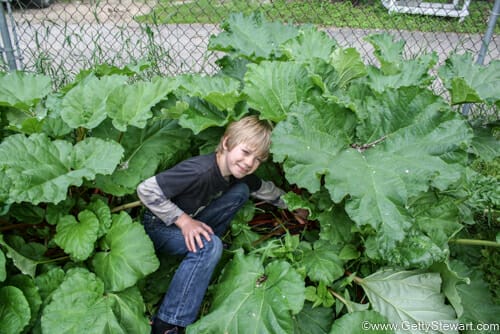
Video: How to harvest your rhubarb
5. Can I harvest rhubarb in the summer and fall?
Yes, you can – BUT you should harvest fewer stalks and harvest less frequently. Rhubarb is a cool weather plant – it does not love hot dry summers and will greatly reduce its growth. During the summer be kind and gentle to your rhubarb. While its growth will pick up again in the fall as the weather cools, it’s still important to leave at least 2/3 of the stalks on the plant so it can draw adequate moisture and nutrients to its roots to survive the winter.
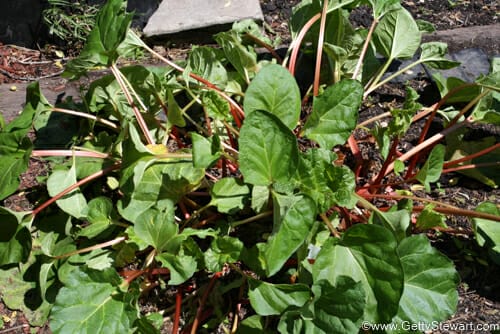
6. Is rhubarb a fruit or a vegetable?
While we use it like a fruit in pies and crisps, rhubarb is technically a vegetable. A fruit is the fleshy part of a plant that comes from a flower and surrounds a seed. We use the stalks of the rhubarb plant, much like the stalks of celery. But it’s okay to call rhubarb a fruit when you’re talking about culinary purposes. In fact, in 1947 a New York court declared it a fruit! So there.

7. How do I care for my rhubarb plant?
Anyone who has a rhubarb plant knows it’s pretty easy to care for and will take a lot of neglect. It can, however be tricky to get started. Show it lots of love (plenty of sun, water and compost) in the first three years to get it established. Then, to ensure the best crop possible, there are a few things you should do every year.
- add compost or well aged manure around your rhubarb in fall or first thing in spring
- remove dead leaves and add a thick layer of mulch on top of the plant in late fall, remove mulch in spring
- provide water if it’s a dry spring and summer
- remove the seed stalk that appears late spring, it will prolong the harvest season by keeping stalks tender
- rhubarb loves sunlight but does not like heat – it will do best in a sunny location, but don’t expect it to do much of anything in the hot summer sun
8. Should I remove the seed stalk?
Yes, when you see the seed head forming, remove it so your rhubarb will continue to produce tender stalks. Once the plant flowers, it will slow its growth and the stalks will become tougher. You can cut all the seed stalks that come up, it won’t damage the plant.
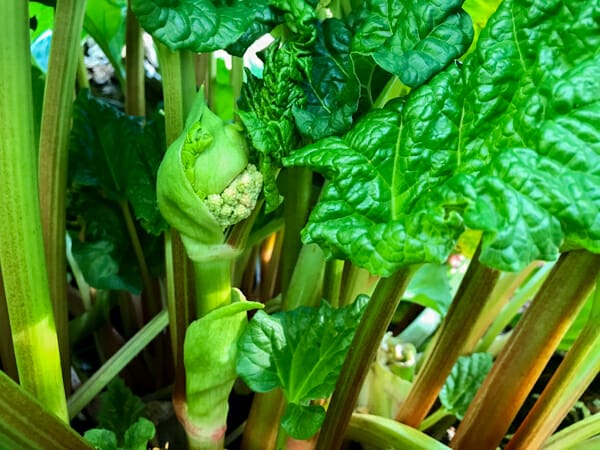
Video: How to remove the seed heads or stalks from your rhubarb
9. Is this wild rhubarb?
If you’re walking in a forest, along a roadside ditch or in a grassy prairie chances are you’ll find what looks like wild rhubarb. Big broad leaves on tall green and red stems. Could it be you found wild rhubarb? Nope, sorry. You likely found burdock. Burdock is the plant that produces those pesky burs that stick to your clothes and/or your dog. Burdock is a biannual, so you’ll see the seed stalks only on second year growth. The stems are more fuzzy or wooly than rhubarb stems and they’re usually hollow, while rhubarb stems are solid throughout (except the seed stalk stem).
Burdock does have edible parts and is highly regarded for medicinal purposes, but do not eat it like you would rhubarb – it is not the same, nor is it a relative of rhubarb.
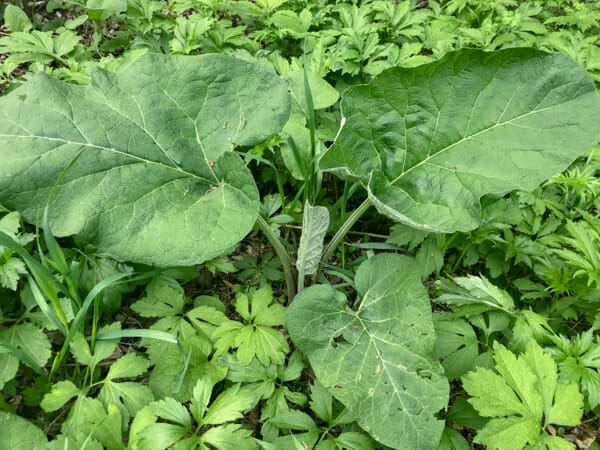
And now, here’s a question for you… what’s your favourite way to enjoy rhubarb?
If you’re looking for tasty rhubarb recipes and how to preserve rhubarb for use throughout the year, my handy dandy e-book on rhubarb – The Rhubarb Cookbook is your go to guide. Or try some of these…
Rhubarb Recipes
- Rhubarb and Caramelized Onion Focaccia
- Rhubarb Streusel Cake with Sweet Yeast Dough
- Strawberry Rhubarb Freezer Jam
- Rhubarb Fruit Leather
- Rhubarb Honey Bran Muffins
- Honey Rhubarb Sesame Chicken
- Rhubarb Juice
- Rhubarb Poppyseed Dressing
- Rhubarb Cinnamon Buns
- Rhubarb Cornmeal Surprise Muffins
- Stewed Rhubarb
- French Toast Fingers with Stewed Rhubarb
- Rhubarb Herbal Tea
- Chia Seed Rhubarb and Strawberry Preserve
- How to Freeze Rhubarb
Sign up to get articles by Getty delivered to your inbox. You’ll get recipes, practical tips and great food information like this. Getty is a Professional Home Economist, speaker and writer putting good food on tables and agendas. She is the author of Manitoba’s best-selling Prairie Fruit Cookbook, Founder of Fruit Share, a mom and veggie gardener.






Hi my red rhubarb died off in winter this year. I thought I had lost it. Bit no it has shot away this spring better than ever. However the stems are now green. Will they go red in winter or has it changed to green
Well isn’t that strange! I’m not sure why it would have changed color. As far as I know, the color of rhubarb has to do with variety not growing conditions. However maybe a change in the acidity of the soil or some other phenomenon has caused it to change. I’d use a watch and see approach but harvest it before it becomes tough or woody.
And just to be absolutely certain, are you 100% sure it’s rhubarb not a weed like burdock that has made itself home where rhubarb used to grow?
Let us know how this turns out!
Getty
Very curious- why did my rhubarb plant fail to seed this year? Plant is very old, 50plus years- time to start new?
Hi Debra,
That is an interesting question, usually people ask why goes to seed and how to prevent it! I don’t actually know why it wouldn’t go to seed, conditions may have been off – not enough water, too much heat at a critical time, not reaching cold enough temps in the winter (rhubarb needs cold winters), some critter interfering? Not sure. After 50+ years, you may want to consider splitting your plant and starting a new patch. Dividing the roots in fall or spring will “reset” the plant and start fresh. You could just take a piece off the root and let the rest continue to grow to see what it might do next year.
Good luck!
Getty
Hey, I’m wondering if the leaves can be used for anything at all in cooking – like, can you boil/cook them, like some other foods that may be dangerous, to make them safe for consumption? Thanks in advance if someone can shed some light on this!
Hi Douglas,
The quick answer is no. Do not try to boil them or consume rhubarb leaves in any way. The oxalic acid present in the leaves is toxic to the kidneys and cannot be boiled away.
Try experimenting with other greens in the garden or forest.
All the best,
Getty
what do you do about the flowers? should i cut them off or leave them? they are taller than me.
Hi June,
I recommend that as soon as you see the seed stalk/flower head forming, you remove it. Cut it off at the bottom of the plant. When the plant is allowed to flower all of its energy will go towards seed production, so fewer edible stalks will grow the rest of the season.
Despite what you might hear, rhubarb stalks are still safe to eat if the plant has flowered.
Getty